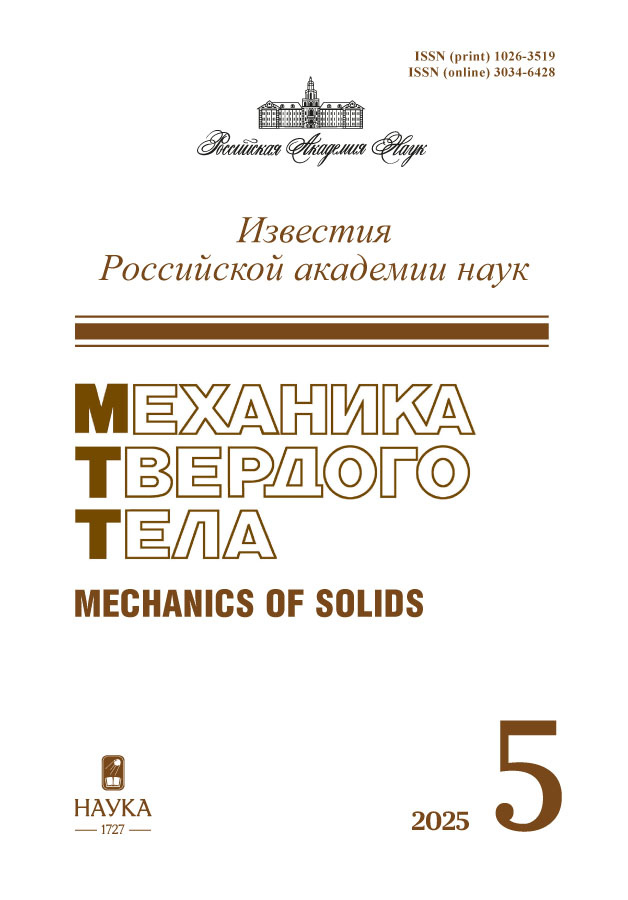Регулярные кватернионные уравнения орбитального движения в гравитационном поле земли в KS-переменных и в их модификациях. Понижение размерности, первые интегралы УРАВНЕНИЙ
- Авторы: Челноков Ю.Н.1
-
Учреждения:
- Институт проблем точной механики и управления РАН
- Выпуск: № 1 (2025)
- Страницы: 75-101
- Раздел: Статьи
- URL: https://ruspoj.com/1026-3519/article/view/680988
- DOI: https://doi.org/10.31857/S1026351925010046
- EDN: https://elibrary.ru/tanagw
- ID: 680988
Цитировать
Полный текст
Аннотация
Рассмотрены регулярные кватернионные дифференциальные уравнения возмущенного орбитального движения космического тела (в частности, космического аппарата, астероида) в гравитационном поле Земли, в которых учитываются зональные, тессеральные и секториальные гармоники поля. Эти уравнения, в отличие от классических уравнений, регулярны (не содержат особых точек типа сингулярности (деления на ноль)) для возмущенного орбитального движения в центральном гравитационном поле Земли. В этих уравнениях основными переменными являются четырехмерные переменные Кустаанхеймо–Штифеля (KS-переменные) или четырехмерные переменные, предложенные автором статьи, в которых уравнения орбитального движения имеют более простую и симметричную структуру в сравнении с уравнениями в KS-переменных. Дополнительными переменными в уравнениях являются энергия орбитального движения и время. Новая независимая переменная связана со временем дифференциальным соотношением, содержащим расстояние от космического тела до центра масс Земли (использовано дифференциальное преобразование времени Зундмана). Предложены регулярные уравнения возмущенного орбитального движения в кватернионных оскулирующих (медленно изменяющихся) переменных. Уравнения удобны для применения методов нелинейной механики и высокоточных численных расчетов, в частности, для прогноза и коррекции орбитального движения космических аппаратов. В случае орбитального движения в гравитационном поле Земли, в описании которого учитываются центральная и зональные гармоники поля, приведены первые интегралы уравнений орбитального движения, имеющих восьмой порядок; рассмотрены замены переменных и преобразования этих уравнений, которые позволили получить для изучения орбитального движения замкнутые системы дифференциальных уравнений шестого порядка, а также системы дифференциальных уравнений четвертого и третьего порядков, в том числе систему дифференциальных уравнений третьего порядка относительно расстояния от космического тела до центра масс Земли и синуса геоцентрической широты, а также систему двух интегро-дифференциальных уравнений первого порядка относительно этих двух переменных.
Ключевые слова
Полный текст
Об авторах
Ю. Н. Челноков
Институт проблем точной механики и управления РАН
Автор, ответственный за переписку.
Email: ChelnokovYuN@gmail.com
Россия, Саратов
Список литературы
- Euler L. De motu rectilineo trium corporum se mutuo attrahentium // Nov. Comm. Petrop. 1765. V. 11. P. 144–151.
- Levi-Civita T. Traettorie singolari ed urbi nel problema ristretto dei tre corpi // Ann. mat. pura appl. 1904. V. 9. P. 1–32.
- Levi-Civita T. Sur la regularization du probleme des trois corps // Acta Math. 1920. V. 42. P. 99–144. https://doi.org/10.1007/BF02418577
- Levi-Civita T. Sur la resolution qualitative du probleme restreint des trois corps // Opere mathematiche. 1956. № 2. P. 411–417.
- Kustaanheimo P. Spinor regularization of the Kepler motion // Ann. Univ. Turku. 1964. V. 73. P. 3–7.
- Kustaanheimo P., Stiefel E. Perturbation theory of Kepler motion based on spinor regularization // J. Reine Anqew. Math. 1965. V. 218. P. 204–219.
- Stiefel E.L., Scheifele G. Linear and Regular Celestial Mechanics. Berlin: Springer, 1971. 350 p. [Штифель Е., Шейфеле Г. Линейная и регулярная небесная механика. М.: Наука, 1975. 304 с.]
- Челноков Ю.Н. К регуляризации уравнений пространственной задачи двух тел // Изв. АН СССР. МТТ. 1981. № 6. С. 12–21.
- Челноков Ю.Н. О регулярных уравнениях пространственной задачи двух тел // Изв. АН СССР. МТТ. 1984. № 1. С. 151–158.
- Waldvogel J. Quaternions and the perturbed Kepler problem // Celestial Mechanics and Dynamical Astronomy. 2006. V. 95. P. 201–212. http://doi.org/10.1007/978-1-4020-5325-2_11
- Waldvogel J. Quaternions for regularizing Celestial Mechanics: the right way // Celestial Mechanics and Dynamical Astronomy. 2008. V. 102. № 1. P. 149–162. http://doi.org/10.1007/s10569-008-9124-y
- Fukushima T. Efficient orbit integration by linear transformation for Kustaanheimo-Stiefel regularization // The Astronomical J. 2005. V. 129. № 5. 2496. http://doi.org/10.1086/429546
- Fukushima T. Numerical comparison of two-body regularizations // The Astronomical J. 2007. V. 133. № 6. 2815. http://doi.org/10.1086/518165
- Челноков Ю.Н., Логинов М.Ю. Новые кватернионные модели регулярной механики космического полета и их приложения в задачах прогноза движения космических тел и инерциальной навигации в космосе // Сборник материалов: XXVIII Санкт-Петербургская международная конференция по интегрированным навигационным системам. Санкт-Петербург, 2021. С. 292–295.
- Челноков Ю.Н., Сапунков Я.Г., Логинов М.Ю., Щекутьев А.Ф. Прогноз и коррекция орбитального движения космического аппарата с использованием регулярных кватернионных уравнений и их решений в переменных Кустаанхеймо–Штифеля и изохронных производных // ПММ. 2023. Т. 87. Вып. 2. С. 124–156. http://doi.org/10.31857/S0032823523020054
- Челноков Ю.Н. Кватернионная регуляризация уравнений возмущенной пространственной ограниченной задачи трех тел. I // Изв. РАН. МТТ. 2017. № 6. С. 24–54.
- Челноков Ю.Н. Кватернионная регуляризация уравнений возмущенной пространственной ограниченной задачи трех тел. II // Изв. РАН. МТТ. 2018. № 6. С. 41–63. http://doi.org/10.31857/S057232990000712-3
- Бордовицына Т.В. Современные численные методы в задачах небесной механики. М.: Наука, 1984. 136 с.
- Бордовицына Т.В., Авдюшев В.А. Теория движения искусственных спутников Земли. Аналитические и численные методы. Томск: Изд-во Том. ун-та, 2007. 178 с.
- Chelnokov Yu.N. Quaternion methods and models of regular celestial mechanics and astrodynamics // Appl. Math. Mech. 2022. V. 43. № 1. P. 21–80. https://doi.org/10.1007/s10483-021-2797-9
- Челноков Ю.Н. Кватернионные и бикватернионные методы и регулярные модели аналитической механики (обзор) // ПММ. 2023. Т. 87. Вып. 4. С. 519–556. https://doi.org/10.31857/S0032823523040033
- Челноков Ю.Н. Кватернионная регуляризация особенностей моделей астродинамики, порождаемых гравитационными силами (обзор) // ПММ. 2023. Т. 87. Вып. 6. С. 915–953. https://doi.org/10.31857/S0032823523060036
- Челноков Ю.Н. Кватернионные уравнения возмущенного движения искусственного спутника Земли // Космические исследования. 2019. Т. 57. № 2. С. 117–131. https://doi.org/10.1134/S002342061902002X
- Абалакин В.К., Аксёнов Е.П., Гребеников Е.А., Дёмин В.Г., Рябов Ю.А. Справочное руководство по небесной механике и астродинамике. М.: Наука, 1976.
- Дубошин Г.Н. Небесная механика: Методы теории движения искусственных небесных тел. М.: Наука, 1983. 351 c.
- Демин В.Г. Движение искусственного спутника в нецентральном поле тяготения. М.–Ижевск: НИЦ “Регулярная и хаотическая динамика”, Ижевский институт компьютерных исследований. 2010. 419 с.
- Челноков Ю.Н. Кватернионные методы в задачах возмущенного центрального движения материальной точки. Ч. 1: Общая теория. Приложения к задаче регуляризации и к задаче о движении ИСЗ. М.: 1985. 36 с. Деп. в ВИНИТИ 13.12.85. № 218628-В.
- Челноков Ю.Н. Применение кватернионов в теории орбитального движения искусственного спутника. II // Космические исследования. 1993. T. 31. Вып. 3. С. 3–15.
Дополнительные файлы











